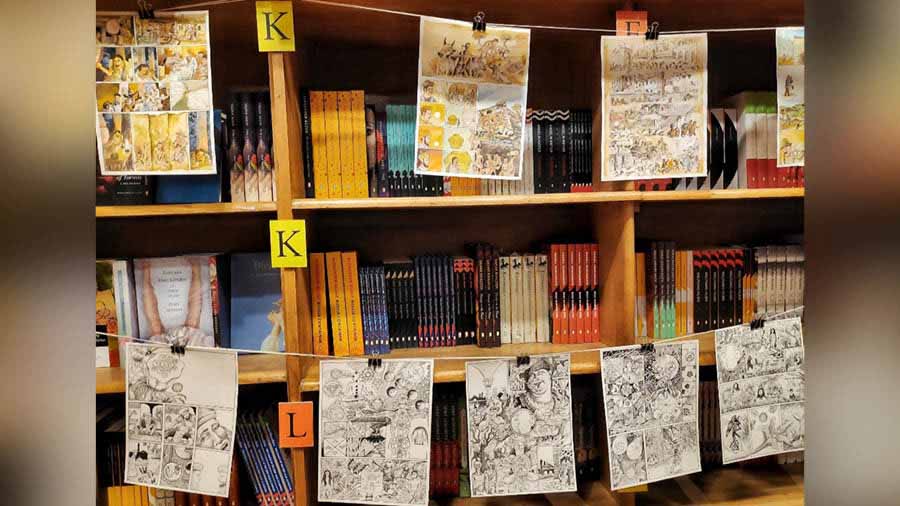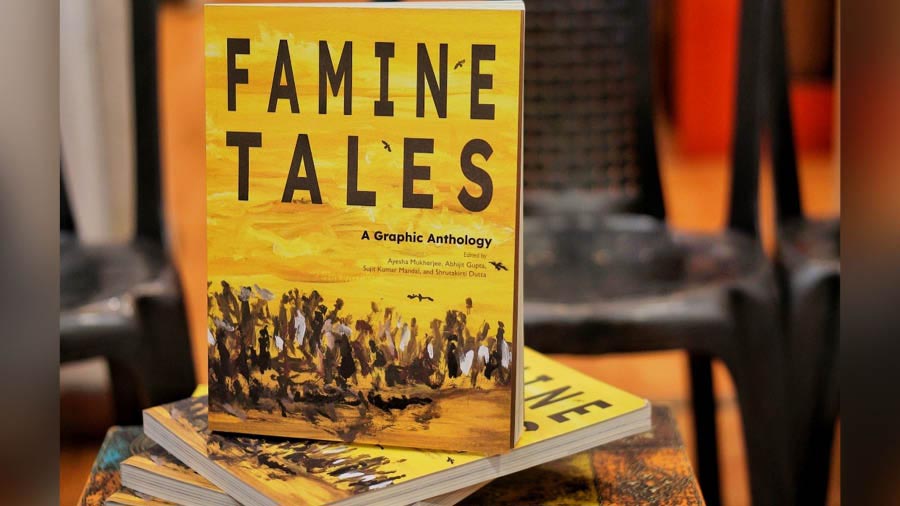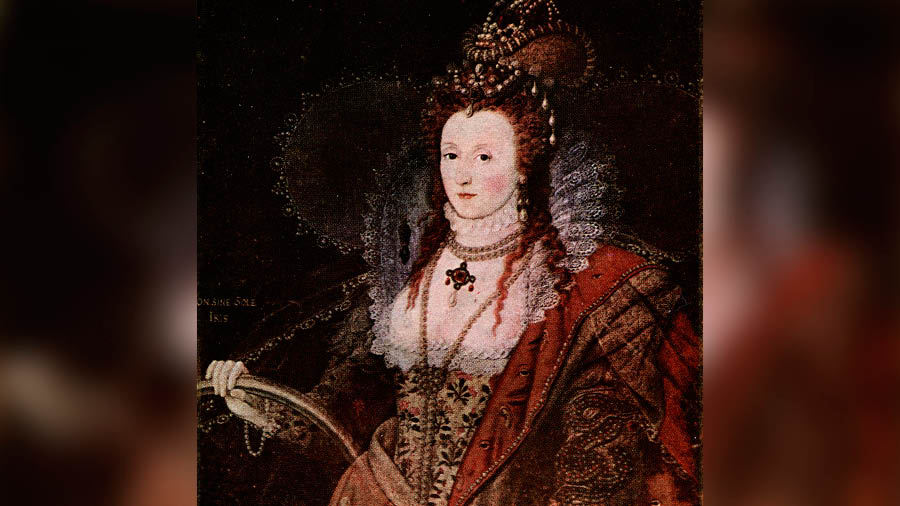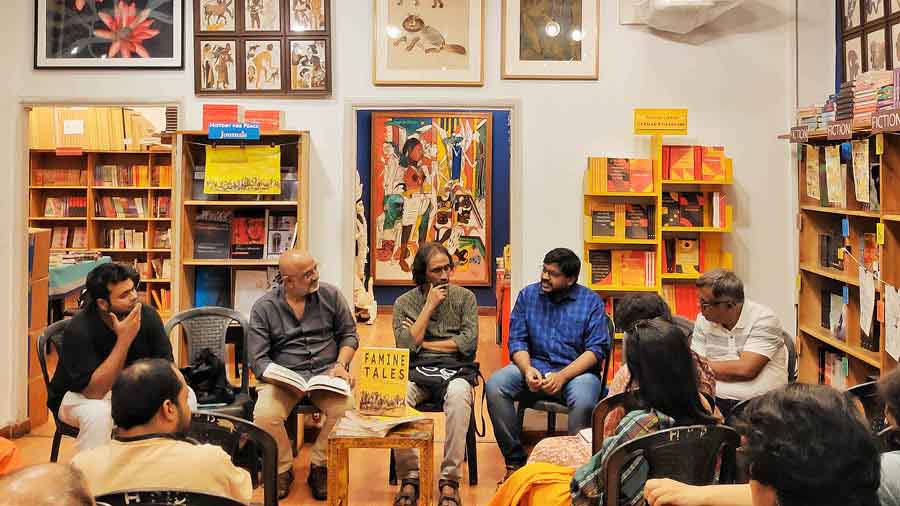“We think that famines in India occurred only after the arrival of the British but that is not correct. Famines have been a part of India’s pre-colonial history,” said noted author and academic Parimal Bhattacharya as he recently discussed Famine Tales: A Graphic Anthology with the editors and artists of the book at the discreetly charming storefront of Seagull Books in south Kolkata’s Bhowanipore.
Famine Tales is the sequel to a project funded by the Arts and Humanities Research Council called Famine and Dearth in India and Britain, 1550-1800, which had been led by Ayesha Mukherjee, professor of English at the University of Exeter and professor Amlan Das Gupta of Jadavpur Univerity. The study culminated in the creation of a web database enabling the exploration of the cultural histories of famine in early modern India and Britain.
The book, edited by Mukherjee, Abhijit Gupta (professor of English at Jadavpur University Press and director of Jadavpur University Press), Sujit Kumar Mandal (professor of comparative literature at Jadavpur University) and Shrutakirti Dutta (PhD student at the department of English, University of Chicago) focuses on the tales of five famines that occurred in India and Britain between the 16th and 18th centuries. These stories have been primarily taken from texts originally written in languages such as Persian, Bengali, Braj Bhasha, Latin and English.

The illustrations of the book through patachitra and comics
“We have tried to portray these stories through patachitra (scroll paintings from Bengal) and comics. The scrolls are based on the narrative poems composed by the late patachitrakar (scroll-painter), Dukhushyam Chitrakar, who hailed from Naya village in Midnapore. Other patachitrakars who have contributed to the book are Jahanara Chitrakar, Rabbani Chitrakar, Rahim and Rahman Chitrakar, Rupanjan Chitrakar and Ushiara Chitrakar, all of whom are from Dukhushyam’s family and carrying his legacy forward,” said Gupta.
The comics artists who contributed to the retelling of the five tales are Trinankur Banerjee, Aratrika Choudhury, Argha Manna, Debkumar Mitra, Sekhar Mukherjee, and Sarbajit Sen.
The event saw the presence of Manna, Banerjee, Mitra, and Sen who shared their experiences of writing the book.

Art Emerging from Dystopia
“When Tintin (Abhijit Gupta) asked me to be a part of the project during the pre-Covid days, I was naturally excited. But I had not read the Mangalkavya completely, and I also required visual references. But he told me that there are no visual references but the only references that could be patachitra. The pandemic created a sort of dystopia and I was extremely disoriented. But the first thing that came to my mind after Abhijit asked me to be a part of the project was that I would interpret the story of the famine in my own way,” said comics artist Sarbajit Sen, whose tale is from Mukundaram Chakravarti’s Chandimangal, called Phullarar Bhoj (Phullarar’s Feast).
This Bengali folk tale is merged with an encounter that Sen had with a young local couple when he was visiting Loleygaon for work in the late-1990s. “The story of the hunter couple, who I encountered at Loleygaon is absolutely true. I went to work at Loleygaon and wanted to make something that the common people would be able to relate to. Incidentally, I had also been working closely with the Thanka painters for a few years and the visual pattern of the Thanka paintings affected me deeply. When I started working, I met a local man who told me that he and his wife were hunting for birds and if they didn’t get any birds for the day they wouldn’t have any food to eat,” said Sen as he explained how he connected his contemporary experience with Phullarar’s story where she, a hunter’s wife, laments the lack of sufficient food throughout the year.
“During the lockdown, I also had a paucity of colours to paint with and somehow I was not able to start drawing. But once I started, it was extremely therapeutic for me. I had already decided that the colour palette would be monochromatic. Then, one of my friends who is also a very popular artist suggested that I could try using ‘khoir’ (catechu) as colour,” recalled Sen, as he elaborated upon the innovative ways in which he created his art.
The Need for Accuracy
When artists Argha Manna and Debkumar Mitra started working on the story of the famine of 1776, called Chhiattorer Monnontor (The Famine of ’76), they realised that there hasn’t been a comprehensive account of the famine which incorporated all the reasons for the disaster that killed 10 million people. Their story is conveyed through an imaginary dialogue between themselves and Sir William Wilson Hunter who wrote The Annals of Rural Bengal.
“Once we started reading, we realised that the amount of information we had to go through was huge. We wanted to make a non-fiction account but Argha suggested that we touch upon all the aspects of the 1776 famine rather than just blaming it upon the British. So, Argha came up with the invention that he would portray himself as an unknown painter who is missing from the pages of history but who has recorded the famine and that his work has been passed down to a fictional natural history painter and printmaker from Calcutta, called Debdulal Mitra. We show that Hunter summons Debdulal Mitra to help him write a report on the famine and that is when Mitra shows Hunter the sketchbook of this anonymous painter that has been given to him by his guru. Initially, we thought that we would want to portray a disagreement between us and Hunter but later settled upon this method of conveying the story. We broke the story into chapters and Argha insisted that everything should be represented as it is,” said Debkumar Mitra explaining the thought process behind selecting the narrative style.
For Manna, it wasn’t just about retelling the story of the famine through comics but producing an accurate work of research. This necessitated the precise representation of the landscape.
However, the artists didn’t find any visual representations of the famine that would allow them to portray the conditions prevalent during the time with veracity.
“At that time Ayesha di got me connected with the India office of the British Library and they informed me about a sketchbook of an anonymous artist who had actually made sketches of Bengal in the 18th century in the form of an accordion book. This painter had not covered the famine but I could get an idea of the landscape from there and that’s also where I got the idea for creating the figure of an unnamed painter for our work,” elaborated Manna.
The Other Side of the Golden Age

Queen Elizabeth I iStock photograph
The rule of Queen Elizabeth I is often considered England’s Golden Age when the country made remarkable economic progress. But the reality for the common masses living at the time was far from glorious.
“During the Golden Age, one of the greatest problems was the distribution of food. Plus, at that time, Europe was experiencing the Little Ice Age causing a famine-like situation in various areas of Europe. Historic accounts of these famines are far and few. The only mention or effect of this famine is found in parish registers. Even though England was progressing, if we study the parish registers, we can see that the death rate was more than 25 per cent because of lack of food. But nobody was really concerned about it because death was extremely common,” mused Trinankur Banerjee who created a comic satire on the troubles that England faced during the Elizabethan period by depicting the issues through the eyes of the character of Sir John Falstaff in the tale Shekkhopir-Deshe Durbhikkha (Famine in Shakespeare-land).
“The only problem that I faced was how I would approach the story. I explored various ways of doing so but my editors were extremely encouraging of all of them and initially, I had a difficult time choosing an approach. However, I am extremely thankful to Jadavpur University and the editors for giving me the creative freedom to create the story in my own way,” concluded Banerjee.
Renowned graphic illustrator and designer Pinaki De was also present in the audience and for him, Famine Tales was “one of the best anthologies” to have been created in the past five years. “It almost seems like the book has been reconstructed from memory which is always difficult to put in a visual idiom. All the artists have done justice but in their own ways, with their signature styles and interpretations of the stories and this has added to the strength of the anthology,” said the artist.
